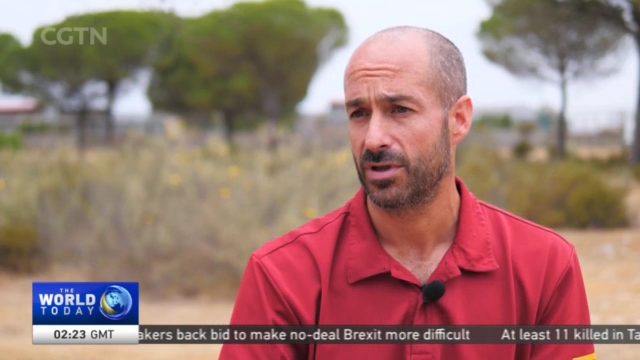
11:12, 19-Jul-2019
Saving Iberian Lynx: Spain brings Europe's largest cat back from extinction
Updated
11:24, 19-Jul-2019

The Iberian Lynx, faced with extinction less than two decades ago, has made an impressive comeback in Spain. Europe's largest cat, native to the Iberian Peninsula, was saved thanks to the pioneering efforts of the Spanish government, and scientists and conservationists from Spain and Portugal. But, its future remains far from secure. CGTN's Filio Kontrafouri reports from Andalusia, in southern Spain.
It's an inspirational conservation story that begins here. At one of Spain's four, Iberian Lynx breeding centers. The aim: to reintroduce captive-bred lynx into the wild to bolster the population. The teams monitor every lynx 24 hours a day, especially the cubs that are bred and then prepared to be released in the wild.
FRANCISCO VILLAESPESA DIRECTOR, BREEDING CENTER OF EL ACEBUCHE "We try to boost their predatory conduct by teaching them to hunt. We don't want them to associate food with their keepers so when they see a human they don't get close thinking they will give them food. We try to teach them to interact with their own kind, so when they're in the wild they can identify with other lynxes and reproduce, that's the final goal of every reintroduction program -that they start reproducing in the wild."
Francisco Villaespesa says 90 percent of the captive-bred lynx is released in the wild. The rest is kept in captivity for reproduction. They are monitored by a high-tech surveillance system from the moment they are born to ensure the reintroduction process moves on smoothly.
FRANCISCO VILLAESPESA DIRECTOR, BREEDING CENTER OF EL ACEBUCHE "With that system we try to control the fights between the animals, monitor the development of the cubs, when they start hunting, when they catch their first rabbit and at the end, when they are close to being released, we have to know if they can hunt or not. What techniques they use, their behavior with humans. And with all this information we evaluate if they can be reintroduced or not."
At the beginning of the 20th century some 100,000 Iberian Lynx roamed southern Spain and Portugal. Hunting, loss of prey and loss of habitat decimated the lynx. By 2002, less than one hundred were left in two isolated pockets of Andalusia, one being here in Doñana. That's when the Spanish government established the captive breeding program. Close to 200 young ones have been released in the wild. And now their total population is nearly 700.
FILIO KONTRAFOURI ANDALUSIA, SPAIN "Few people have ever seen an Iberian Lynx in the wild. And while we spent hours at the Donana Park looking for one, we did not become one of those people. The Iberian Lynx is not only extremely rare. It is also one of the most elusive animals in the world."
It is a predator and its main prey is rabbits. Yet, the rabbit population in the wild is declining. And survives in areas that, Luis Suarez says, are full of threats for the lynx. Boosting and retaining a healthy rabbit population is one of the biggest challenges for lynx conservationists.
LUIS SUAREZ ENDANGERED SPECIES PROGRAM DIRECTOR, WWF SPAIN "The key for the survival of the lynx long-term is having enough food in good habitats and this is something that we are still not able to manage. We are reintroducing lynxes in those areas where the density of the rabbits is high, the habitat is good but these areas are scarce. We have a lot of areas with good habitat but no rabbits and a lot of areas with a lot of rabbits but are not good enough."
Busy roads and human activity are some of the biggest dangers for the Iberian Lynx. Despite signs warning of its presence, close to 100 have been killed by cars in the last five years. Still, thanks to the captive breeding program, the Iberian Lynx is downgraded from 'critically endangered' to 'endangered'. Europe's largest cat has recovered. And now there's hope it could even thrive again. Filio Kontrafouri, CGTN, Andalusia, Spain.
SITEMAP
Copyright © 2018 CGTN. Beijing ICP prepared NO.16065310-3
Copyright © 2018 CGTN. Beijing ICP prepared NO.16065310-3